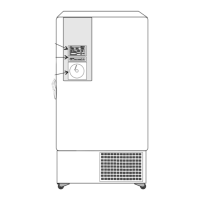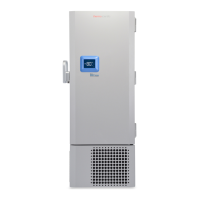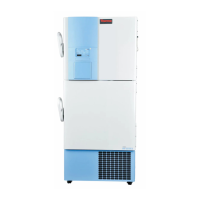Do you have a question about the Thermo Scientific 8600 Series and is the answer not in the manual?
Explains the function of control panel keys, displays, and indicators for operating the freezer.
Details how to navigate and operate the freezer using the keypad controls and modes.
Describes the system status and alarm messages shown in the message center.
Step-by-step guide for removing the freezer from its shipping pallet and preparing it for movement.
Recommendations for selecting an appropriate environment for freezer placement and required clearances.
Instructions for installing the wall bumper parts included with the freezer.
Guidance on inserting shelf clips and placing shelves within the freezer cabinet.
Information on the freezer's data communication interface and its default settings.
Details on connecting external alarm systems and configuring analog output signals.
Steps for securely connecting the power cord to the freezer unit.
Instructions for connecting the freezer to a suitable electrical power source.
Guide to initiating the freezer's power sequence and checking initial system status.
Instructions on how to adjust the main temperature set point for the freezer chamber.
Procedure to configure the upper temperature limit that triggers an alarm.
Procedure to configure the lower temperature limit that triggers an alarm.
Information on the default access code and how to modify it for security.
Describes the default operating mode and information displayed during normal freezer operation.
Steps to ensure accurate temperature readings by calibrating the main control probe.
Instructions for calibrating an optional probe to monitor sample temperatures.
Procedure to test the functionality of the high temperature alarm system.
Procedure to test the functionality of the low temperature alarm system.
Guide on how to test the charge level of the freezer's internal battery.
Instructions for setting a passcode to control access to configuration modes.
How to assign a unique address for RS485 communication with the freezer.
Instructions for selecting the type of gas used by the backup system.
General information about the freezer's alarm system and message center display.
Troubleshooting steps for when the freezer detects an incorrect power source.
Information on diagnosing and resolving high stage compressor and fan system failures.
Explains alarms related to sensor failures and their impact on freezer operation.
Routine cleaning instructions for the freezer's outer surfaces.
Steps for cleaning the air filter to ensure proper ventilation and performance.
Instructions for cleaning the condenser fins to maintain cooling efficiency.
Procedure for cleaning the water-cooled condenser using a CIP process.
Procedure for safely defrosting the freezer chamber and cleaning the interior.
Routine cleaning of the door gasket to prevent frost build-up and ensure a proper seal.
Importance of maintaining the vacuum relief port to ensure easy door opening.
Instructions for locating, replacing, and disposing of the freezer's batteries.
Steps to prepare the freezer for extended periods of storage.
Details the function and operation of the built-in backup system for temperature maintenance.
Steps for installing the gas injection components for the backup system.
Guidance on properly installing an optional temperature probe for monitoring.
Instructions for connecting the probe and solenoid to the BUS system.
Explanation of the BUS control panel indicators and functions.
How to configure the temperature set point for the backup system.
Procedure to verify the proper operation of the backup system after installation.
Steps for safely disconnecting the backup system from its gas supply.
Instructions for loading chart paper into the optional chart recorder.
How to select different temperature ranges for the chart recorder.
Procedure for calibrating the chart recorder against an accurate thermometer.
Information on the datalogger system for monitoring and documenting temperature data.
Details on the water-cooled condenser option and its specifications.
Description of the five inner door option for enhanced sample organization.
Provides detailed technical specifications for various Model 8600 freezer units.
Outlines safety requirements including altitude, temperature, humidity, and voltage fluctuations.
Visual breakdown of the heat exchanger assembly components.
Visual breakdown of the freezer cabinet components for identification and assembly.
Visual breakdown of freezer door components, including single and double door types.
Visual breakdown of the freezer base unit components.
Visual breakdown of the relay enclosure assembly components.
Diagrams illustrating the high and low temperature stage refrigeration circuits.
Diagrams detailing the freezer's electrical connections, components, and wiring.
Outlines the terms and conditions of the manufacturer's warranty for ULT freezer units.
Specific warranty terms for international dealers and distributors.
Provides essential safety guidelines for handling liquid nitrogen.
Explains the primary hazards associated with liquid nitrogen use.
Offers safety instructions for storing and using liquid carbon dioxide.
Provides immediate first aid steps for exposure to cryogenic materials or gases.
| Type | Ultra-Low Temperature Freezer |
|---|---|
| Temperature Range | -50°C to -86°C |
| Defrost Method | Manual |
| Insulation | High-density polyurethane foam |
| Controller Type | Microprocessor |
| Certifications/Compliance | CE, UL, CSA |
| Shelves | Adjustable shelves |
| Alarm System | Audible and visual alarms for high/low temperature, power failure, door ajar, and system errors |











